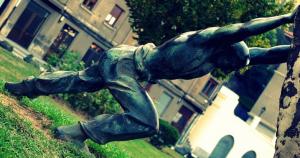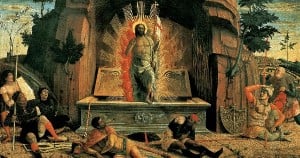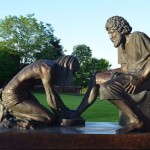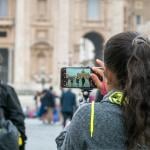 John 20:24-31
John 20:24-31
“Blessed are they that have not seen, and yet have believed” (John 20:29).
That’s us: we have not seen Jesus Christ in the flesh, and yet we believe. If this is true for you today, then you are blessed!
And yet how often are we like St. Thomas after all. How often we have witnessed the testimony of Jesus Christ in our lives and yet seem unable to see Him. How often do we believe, and yet we don’t believe?
How can we learn from St. Thomas today? I wish it were as easy as having Jesus appear before each of us and allowing us to see the mark of the nails in His flesh and to thrust our hands into His sides. Of course, having such direct testimony wouldn’t require as much faith.
Still, I’d like to be able to do it.
And yet Jesus Himself says that we are blessed if we believe without having seen in this way. Having the Holy Spirit in a way that Thomas did not yet have, desiring faith and yet desiring to see Him, and yet having Him be in heaven – how can we see Him and yet have faith? Can we have the blessing of Thomas without doubting like Thomas?
What if we were able to see the marks of the nails and the Crucifixion and able to put our hands into His body?
I think we can. But it requires faith.
What if we saw Thomas’ request not in terms of the physical body of Jesus Christ, now at the right hand of the Father, but in terms of His Body here on earth – the Church? Suddenly, marvelous possibilities for faith and blessing manifest themselves.
First, there is Jesus Christ on the altar during every Lord’s Supper: do you see Him? No, He’s not spread out like a patient etherized upon a table, but I swear that He’s there. When we presume to come to the Lord in His sacred Supper, do we have faith that He’s really there? Do we see Him offering Himself to us, or only a human who politely asks us to try and remember Jesus? Is it Jesus of whom we are partaking, or is it only bread and wine, or grape juice and crackers?
Maybe there’s a reason that the priest or elder gives us the bread and the wine, rather than us presuming to take it, and maybe that reason is because Jesus Christ is acting through the priest or pastor. Isn’t the whole idea of the Church that Jesus Christ is truly present in us to do His will and speak His Word?
Is this so strange to us? Do we not in other parts of our Christian life believe that it is Jesus Christ acting through us? Then why, when we come to the Lord’s Supper, of all places and all times, do we suddenly become agnostic or atheistic?
The Lord who had the nails pounded into His flesh and the spear thrust into His side is there at His table. He’s there on His altar, not being sacrificed again, but offering and re-presenting the one full, perfect, and sufficient sacrifice, once offered. By eating His Body and drinking His blood, we believe, though we have not seen, and thus receive His blessing.
But what is true specifically for the Sacrament of the Holy Communion is true generally for the life of the Church (see Erlandson’s Special and General Theories of Sacramentality from a previous Daily Bread). What if we saw the nails and put our hands in His Body, by seeing Him in His Church?
Do you not see a suffering Church today, a suffering Jesus Christ? If you look at all of Him, you will see this suffering in the persecuted church (“Why do you persecute me?”) But you will also see and feel Him in the suffering present in your local Body of Christ. There are suffering servants of the Lord in your midst, and their suffering is showing forth Jesus Christ to you. They are walking, talking reminders of the tragedy of sin and its ravages in our lives. And those who are enduring their suffering patiently, as if they are the sufferings of Christ, are speaking to you of a glory that awaits those united to Him in His suffering.
But, having come to the Body of Christ, with its nail prints and torn side, we are squeamish about putting our hands in Him to touch this suffering. We prefer to stay safely outside, as if by so doing we can avoid it. But by separating the suffering in our lives and the lives of others from our lives in Christ, we are, in actuality, preventing ourselves from fully seeing Him. We must, therefore, embrace the suffering, not as a good thing in and of itself, but as a means of embracing the One who suffered for us and who sacrificed Himself for us.
There is still more to see, however. The Jesus who Thomas saw, marked hands and open side and all, was not only wounded and dead but is also now alive. Those marks are not just the marks of a suffering Church and suffering Christians but also marks of the Resurrection from the dead and ultimate deliverance from suffering. For though we don’t see Him in all of His glory now, and though we aren’t healed from all of our suffering, every point of suffering in the lives of the saints and every death is now a reminder of the One who has triumphed over suffering and death.
Even in this life, we have all witnessed the resurrected Lord, complete with the signs of His suffering and death. After the suffering, and sometimes even through it, we see His mighty deliverance and healing in our lives.
Suffering is therefore no longer just suffering but also a blessing because it leads us to the Lord. It is the hand of the One with the nail prints in His hands upon us, touching us, becoming one with us, and blessing us. And it is our suffering, nail-printed hands, which we, along with Thomas, put in His side, partaking of both His death and life, His suffering and His glory.
Easter is partially Easter because we have first experienced Good Friday.
“Blessed are they that have not seen, and yet have believed.”
Point for Meditation:
- Reflect upon the suffering in your life or in the life of another. How may you allow Jesus to use this as a means of blessing you?
- Reflect upon the ways in which the Lord has delivered you or another from suffering and blessed you.
Prayer: Lord Jesus Christ, by your patience in suffering you hallowed earthly pain and gave us the example of obedience to your Father’s will: Be near me in my time of weakness and pain; sustain me by your grace, that my strength and courage may not fail; heal me according to your will; and help me always to believe that what happens to me here is of little account if you hold me in eternal life, my Lord and my God. Amen.
Resolution: I resolve to find one way to see Jesus Christ today, especially through the suffering in my life today.
© 2016 Fr. Charles Erlandson












